Text
Discussion Leader Presentation: Infernal Affairs and The Departed
Linda Williams’ “Film Bodies: Gender, Genre, and Excess” takes an interesting approach to the different ways film can invoke a response upon the viewer. She breaks up these “sensations” into three categories; sex, violence, and emotion, stating “gratuitous sex, gratuitous violence and terror, gratuitous emotion are frequent epitaphs hurled at the phenomenon of the ‘sensational’ in pornography, horror, and melodrama”. Examining in detail the three genres, the author delves deeper into the intended audience of each, and how these excesses have taken root in film. She connects these “ecstasies” back to gender, referencing how despite the large variety of intended audiences in gender and age, the female body is almost always at the center, experiencing the onscreen gratuities. Williams’ states “in each of these genres the bodies of women figured on the screen have functioned traditionally as the primary embodiments of pleasure, fear, and pain”. Her overall analysis as it relates to Infernal Affairs is that “the success of these genres seems a self-evident matter of measuring bodily responses”, meaning within these three genres, the success of a film is largely dependent on the audiences “mimicry” of these “sensations”, as she puts it.
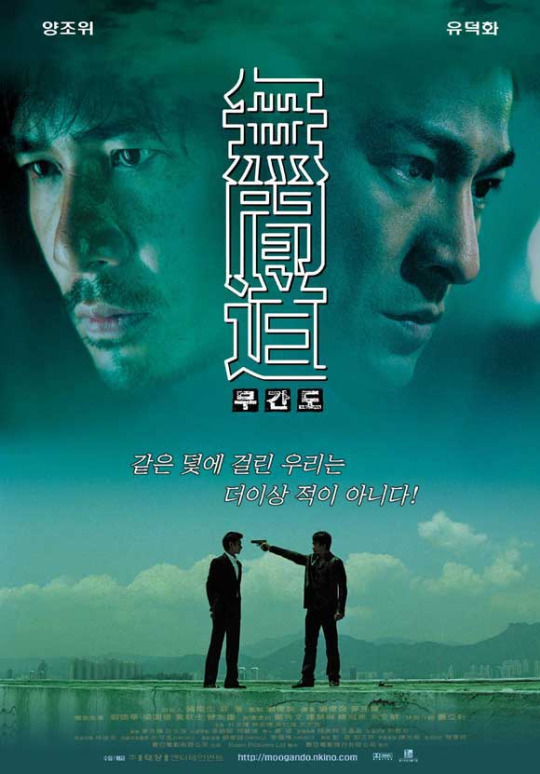
Infernal Affairs is a foreign film produced in Hong Kong and directed by Andrew Lau and Alan Mak. It tells the story of Chan Wing-Yan and Lau Kin Ming, both young recruits on opposite sides of the law. Chan works for the police department, and is put undercover in the criminal group known as the Triads. At the same time Lau is put into the police cadet program in order to become a long term mole for the Triads. Both respectively rise through the ranks of the organizations, and the films action begins with Triad leader Hon going through with a cocaine deal. Chan, who is the police mole in the criminal group, informs police chief Wong, who is the only one who knows about his undercover assignment. As the police are on their way to arrest Hon, his own mole Lau tells him to dump the coke and no hard evidence can be found against the Triad crime boss. At this point each respective leader realizes the other has a mole planted, and both of our main characters are tasked with finding out who it is.
When things become too dangerous Wong tries to pull Chan from his work with the Triads, but Lau, with the help of his subordinate Inspector B, track him. Lau relays Wong’s location to Hon. He sends triads to kill him, and they end up successfully pushing him off the roof. A shoot out between sides ensues, and a triad drives Chan away from the scene, but later dies from a gunshot wound. Hon assumes he was the mole and that Chan killed him to protect the organization.
Back at police headquarters, Chan soon realizes that Lau is actually the mole and leaves. They decide to meet on the same rooftop where Wong was killed, and Lau begs Chan to allow him to remain as a cop. Chan holds him at gunpoint, and as they take the lift down, he is killed by Inspector B, who is revealed to be a second mole within the police force. Lau then panics, not wanting to give up the life he’s become accustomed to, and kills B, ending the mole hunt and finally becoming a “good guy” cop. The movie ends with Lau discovering months later that Chan really was part of the police force, and saluting his coffin at his funeral.
The film fits into what Williams’ was describing in her article as melodrama, where the characters and acting are excessive in their emotions in an attempt to get the audience to feel the same thing. During moments of emotion, a lot of close ups of the face are used, and black and white filters are brought in to amplify the drama of the scenes.
youtube
This is clearly shown in the last action sequence of the movie. Upon Chan’s death, we see alternating close ups of Lau’s and Chan’s face, along with emotional flashbacks to pivotal moments in Lau’s transition to being a “good guy”. These edits are coupled with sad slow music and black and white filters. All of this would most likely be considered excessive by Williams’ standards.

The other movie I looked at was The Departed. Directed by Martin Scorsese, the film is the american remake of Infernal Affairs. The plots are pretty similar, following the same double undercover agent set up. Irish mob boss Frank Costello introduces Colin Sullivan into the Massachusetts police force as a mole, where he eventually gets accepted into the special investigations unit focusing on organized crime. At the same time police force captain Queenan recruits Billy Costigan to go undercover as a member of the irish mob.
youtube
Although the films are similar, the american version takes a more naturalistic approach, focusing on action scenes without the use of dramatic close ups and slow motion. However it still fits into Williams’ theology in a similar sense, focusing more so on the character’s love interest, police psychiatrist Madolyn Madden. She plays a pivotal role in having insight into each respective character’s personality and motivations, as they are both engaged in romantic relationships with her. She even has a substantial role in the ending scene, where Sullivan tries to speak with her at Costigan’s funeral and she ignores him.
youtube
This scene shows how The Departed can still be considered a melodrama by Williams’ standards, as it plays into the gratuitous emotion and mimicry of sympathy from the audience. She states “even when the pleasure of viewing has typically been constructed for masculine spectators… it is the female body… that has offered the most sensational sight”. The american version also succumbs to more gore than the Hong Kong version, playing into Williams’ description of excess violence.

1. Based on Williams’ definition of excess in genre, do you believe that modern film plays into this idea of sensationalism in the form of excessive sex, violence, and emotion?
2.Do you think Williams’ was correct in her analysis that pornography, horror, and melodrama contain the most excess of sensation in film genre?
3.What other films use this idea of gratuitous displays of sensation to capitalize on an audience’s mimicry and do well in the box office?
0 notes
Text
Discussion Leader Presentation: Eve’s Bayou & The Help
bell hooks writes to testify to the “prolonged silence of black women as spectators and critics was a response to absence, to cinematic negation.” hooks says, “With the possible exception of early race movies, black female spectators have had to develop looking relations within a cinematic context that constructs our presence as absence, that denies the ‘body’ of the black female so as to perpetuate white supremacy and with it a phallocentric spectatorship where the woman to be looked at and desired is 'white.'” Film such as Eve’s Bayou and The Help, use their narrative plots to portray an accurate account of black female spectatorship through messages of encouragement, inclusion, and most importantly empowerment as they defy the societal constructs white cinema has created through the lens of an “oppositional gaze.”
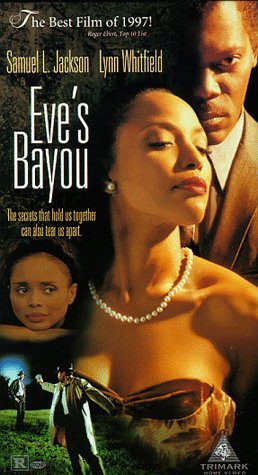
bell hooks
bell hooks is a “pen name” for Gloria Jean Watkins. bell hooks was, and still is, one of the most powerful black women of all time. She wrote about the power that women have: the power to turn racial stereotypes on their head through politics and feminist ideals that have set a precedent in our society. She writes about the intersectionality of race, gender, and the capitalistic views society has on black people. She keeps her name lowercase to emphasize the importance of the subjects she writes about rather than herself as a person.
Eve’s Bayou - Directed by Kasi Lemmons (1997)
Eve’s Bayou is about a ten year old girl who sees first-hand her father’s choices of a love affair, molestation of her sister, and other heavy sexual conflicts. The movie begins at a house party in Eve’s home hosted by her parents. She is saddened when her father invites her older sister to dance and she hides out in the wine cellar, where she eventually fell asleep. She is awakened by her father making love to another woman, who was sexualized in the opening scene. As the plot thickens, the father’s problems become more developed and increasingly worse as he eventually molested Eve’s sister. Through her interests in witchcraft, Eve eventually sets a fatal spell on her father in spite of the crimes he’s committed. The movie concludes with Eve finding out the truth of the molestation, as the father had blamed Eve’s sister, yet Eve finds the truth.
This film seeks to connect Black Womanhood with feminists ideals on sexuality, mistreatment, and misrepresentations. As a black woman herself, Kasi Lemmons, included scenes of adultery, sensual eroticism, supernaturalism through spiritual powers - tying all of these subject back to how black ancestry is portrayed inaccurately in Hollywood. Her focus was on depicting the more social and family oriented problems faced by middle class Blacks in segregated Louisiana.

The Help (2011)- Directed by Tate Taylor
The Help is about a young white journalist’s journey to exploit the mistreatment of the black maids in her town of Jackson, Mississippi during the Civil Rights Movement. The maids were Aibileen Clark and Minny Jackson. The journalist wrote from the perspective of the maids to expose the racism and undertones of capitalism they faced. She named her work “The Help” in order to gain mass attention of the mistreatment. They movie is created to show the strength these women had rather. The focus was on their testimonial recounts rather than the white people or journalist. Tate Taylor is the white male that directed The Help. He grew up in Jackson, Mississippi where he was introduced to racial segregation and profiling, sit-ins, and protests. He said he feels that he truly bled his Mississppi days into the film. His film was based off of the book written by Kathryn Stockett. When asked about why he chose to make the book into a movie, he said, “‘It’s so great, usually these are about civil rights leaders, Malcolm X, Martin Luther King, but this is about normal, everyday African American women doing something.’ So I think that resonated too.” The success of this story is that Taylor didn’t make it about the white people or the white experiences with the black people. He made it about the black females and their testimonial accounts. He interviewed frail ladies to get their accounts and included them in several scenes. I resonate bell hooks’ quote, “That all attempts to repress our/ black peoples’ right to gaze had produced in us an overwhelming longing to look, a rebellious desire, an oppositional gaze. By courageously looking, we defiantly declared: 'Not only will I stare. I want my look to change reality.” This speaks of how powerful the actresses in this film were portrayed.
youtube
“Practically, it is a definition which implies that all sexist thinking and action is the problem, whether those who perpetuate it are female or male, child or adult. It is also broad enough to include an understanding of systemic institutionalized sexism. As a definition it is open-ended. To understand feminism it implies one has to necessarily understand sexism.” - bell hooks
In conclusion, bell hooks’ theories of the “oppositional gaze” and the clear division between the human race have long been portrayed through the cinematic society. Thus, these films -Eve’s Bayou and The Help - support her claims in bringing the racial undertones and intersectionalities of feminist ideals and proper treatment to the forefront of current cinematic releases.
Questions:
Share some ideas about how you think women in film are considered to be the standard of beauty. Name people, films, etc.
Are there other films you can think of that poorly demonstrate blacks’ lifestyles and set the beauty standard to women? Provide examples.
Do you feel Hollywood is making a conscious effort to change the way in which black people and minorities are represented.
What are some other controversial narratives that have long been apart of film, but little effort has been done to change the way these people are portrayed?
youtube
youtube
youtube
4:15 black/white director
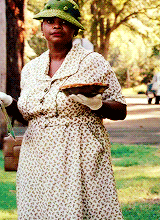
https://www.cinemablend.com/new/Exclusive-Interview-Help-Director-Tate-Taylor-26111.html
1 note
·
View note
Text
Discussion Leader Presentation
Rick Altman: “A Semantic/Syntactic Approach to Film Genre”
In his dissertation, Rick Altman attempts to define a theory that will most accurately describe genre, since previous theories contradict each other. His semantic/syntactic “dual” approach includes the semantic and syntactic definitions of genre. Semantic definitions include conventions of a genre like characters, shots, location, etc. These are more typical markers of genre. Syntactic definitions of genre are more abstract and include underlying themes that are built from the semantic elements. Atlman states, “The semantic approach thus stresses the genre’s building blocks, while the syntactic view privileges the structures into which they are arranged.” Both definitions combined most accurately describe genre. Altman uses the example of the Western genre. The semantic definition includes “a film, whose action, situated in the American West, is consistent with the atmosphere, the values, and the conditions of existence of the Far West between between 1840-1900.” The syntactic definition is described as follows: “…the western is always set on or near a frontier, where man encounters his uncivilized double. The western thus takes place on the border between two lands, between two eras, and with a hero who remains divided between two value systems”.
35 Shots of Rum or 35 Rhums (2008)
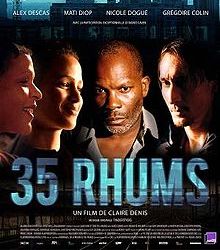
35 Shots of Rum is a film that tells the story of Lionel, a widower and Paris train driver, and his daughter Josephine. Josephine works at a music store and is an Anthropology student. Lionel practically raised Josephine and they have grown to become extremely close while also isolating themselves from others. They have lived alone with each other for years. They, however, have had friendship with their neighbors, Gabrielle and Noé, for a long time. Gabrielle is a taxi driver who has feelings for Lionel and acts motherly toward Josephine. Noé is a young man with an unstable career and lives with his cat. Noé had feelings towards Josephine.
All of the characters are content in their lifestyles, but soon realize they have to move on. Lionel attends his friend’s retirement party and decides not to take the traditional 35 shots of rum, but he realizes that time is going by. Josephine is in college and will soon go off to live her own life, and Lionel must accept this. When stranded in bar after their car breaks down, Noé’s feelings for Josephine come out. Noé’s cat dies, he decides to take a job in Brazil, and Josephine decides to marry him. Before the wedding, Lionel and Josephine take a trip to Germany to visit the mother’s grave after Lionel’s former co-worker commits suicide. At Josephine and Noé’s wedding, Lionel celebrates and takes the 35 shots of rum. He then goes back to his house to live alone.
This film fits into the semantic/syntactic definition of a drama film. The semantic definition of drama can consist of realistic characters in realistic settings. This can also include some techniques such as dramatic sounds and music. The syntactic definition involves the interaction between the semantic elements, like the characters. There is always some emotional dilemma, romance, or family struggle.
Using Altman’s approach to genre, we can confidently classify 35 shots of Rum as a drama. It contains the semantic elements like realistic characters in realistic settings. The film’s characters include a widower father raiding and living with his daughter in a mediocre apartment in France.
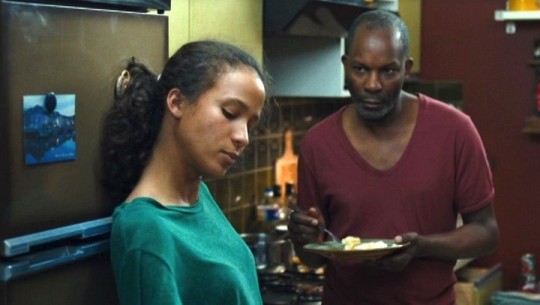
The syntactic elements of the drama genre can be shown in the scene below. Although there isn’t really any dialogue, the viewer can discern the emotional relationships between the characters. There is a romantic relation between Josephine and Noé and Lionel’s facial expression shows that he expericning some emotional distress as he realizes that he won’t have his daughter forever and she will eventually move on.
youtube
A Million Ways to Die in the West (2014)
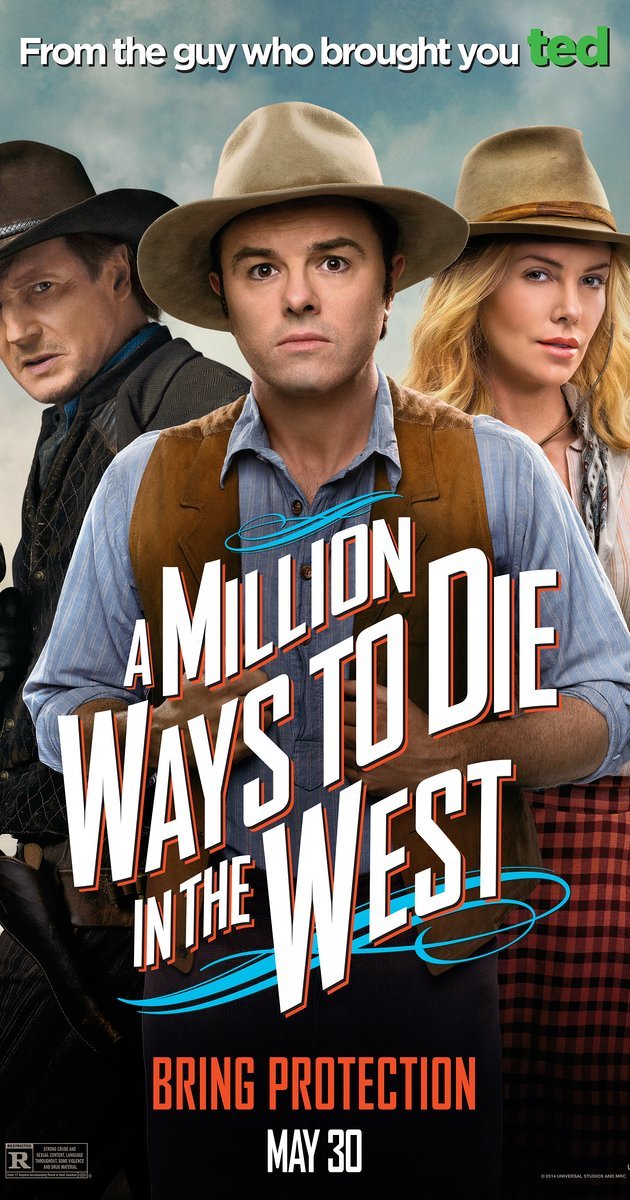
This Seth MacFarlane film is about the American West in 1882. Albert Stark (Seth MacFarlane) is a sheep farmer in the old west who has been left by his girlfriend for more successful man. He is convinced that the old west has nothing to offer him an even will try to kill him, so we wants to move to San Francisco. A new woman, Anna, arrives and Albert immediately takes to her. They develop some kind of relationship and kiss. It is then revealed that the new outlaw, Clinch (Liam Neeson), is her husband he and demands to duel Albert. Albert helps Anna escape Clinch, then he escapes Clinch and the west himself. On his journey, he realizes he loves Anna and decides to go back to the west and duel Clinch. He beats Clinch in the duel by poisoning him and enters his relationship with Anna.
The genre of this film fits in with Altman’s semantic/syntactic definitions of the western. The semantic definition includes “a film, whose action, situated in the American West, is consistent with the atmosphere, the values, and the conditions of existence of the Far West between between 1840-1900.”
youtube
The syntactic definition is described as follows: “…the western is always set on or near a frontier, where man encounters his uncivilized double. The western thus takes place on the border between two lands, between two eras, and with a hero who remains divided between two value systems”.
youtube
**Genres do not have to be mutually exclusive. Obviously this film is also a comedy as evidenced on its clear emphasis on humor.
Discussion Questions:
1. Considering Altman’s theory on genre, do you think that some films more strongly represent a genre than others? For example is A Million Ways to Die in the West just as much of a Western as Western classics like My Darling Clementine or McCabe and Mrs. Miller?
2. Why do you think genres are satisfying for audiences?
3. What are some other films that fit in the semantic/syntactic definition of more than on genre?
0 notes
Text
Discussion Leader Presentation
Monty Python and the Holy Grail (dir. Terry Gilliam and Terry Jones, 1975)
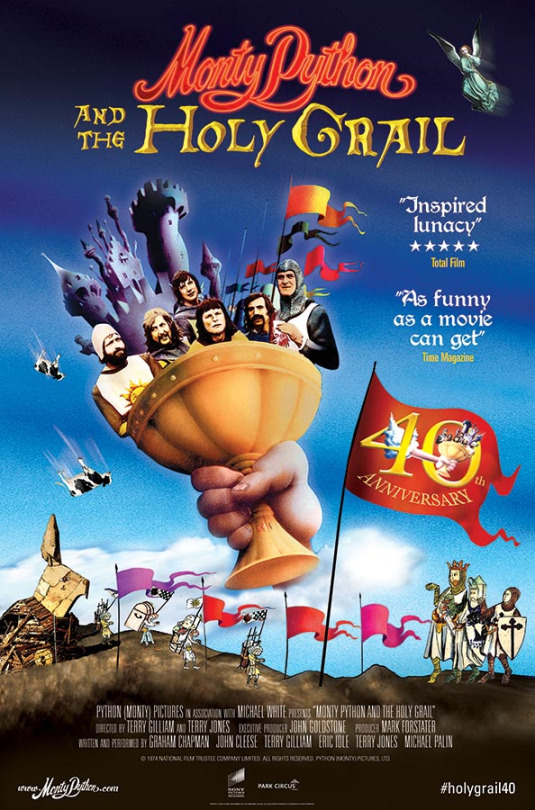
Monty Python is a film that follows the adventures (or more likely misadventures) of King Arthur and the knights of the round table as they quest to find the Holy Grail. The movie consists of many different comedy sketches as the team travels through ancient Britain during the dark ages. The movie begins with King Arthur assembling his knights, travelling through treacherous lands, and facing valiant foes to reach the famed Holy Grail. The entire movie is hard to describe without getting into too much detail but essentially the story subverts the classic Hero’s journey every chance it gets by cleverly using comedy sketches to stitch together the overarching story.
For those who do not know what Monty Python (or the Pythons) they are a comedy group from the United Kingdom who had a television series called Monty Python’s Flying Circus which first aired in 1968 and can be compared to the British version of Saturday Night Live where the show consists mainly of comedy sketches. It is because of this background that their films take this sort of fantastical, outrageous comedy style. Christian Metz writes in his essay Some Points in the Semiotics of the Cinema “The pioneers of ‘cinematographic language’… couldn’t care less about ‘formal’ research conducted for its own sake… they cared little about the symbolic. Philosophical, or human ‘message’ of their films. Men of denotation rather than connotation, they wanted above all to tell a story; they were not content unless they could subject the continuous, analogical material of photographic duplication to the articulations…of narrative discourse.” And this is exactly what the creators of Monty Python and the Holy Grail set out to do. The perfect example of not caring at all about the connotative nature of a film and purely devoting all energy to the denotative half of filmmaking. The film uses the guise of a hero’s journey to bring the viewer a narrative strung along by narratives.
A scene that perfectly embodies the films subversion and general lack of care for the “normal” story narrative is the Black Knight scene.
youtube
The black knight guards a tiny pathetic bridge. He is an “invincible” foe and he keeps fighting no matter what. Usually what would happen is the protagonist would best the foe and they would team up to complete the quest but in this film that is not the case. The entire scene is also pointless in terms of the narrative, it does nothing to further the story or give the viewers a deeper knowledge of the characters. It is simply a funny comedy sketch that laughs in the face of the classic Hero’s Journey.
Another scene that greatly depicts the unusual story telling narrative is a scene where the heroes must cross a treacherous bridge but only after answering the bridge keepers three questions.
youtube
Usually this is where the heroes would have to prove their worth through a test of wisdom but that is not the case in this film as the questions seem to start in the normal direction but then shift into a seemingly random form. The bridge keeper asks questions such as “what is the capital of Assyria” and “what is your favorite color?” Just like the rest of the film this scene subverts what is expected in a story such as this one into something different and unexpected for the sake of comedy.
The Princess Bride (dir. Rob Reiner, 1987)
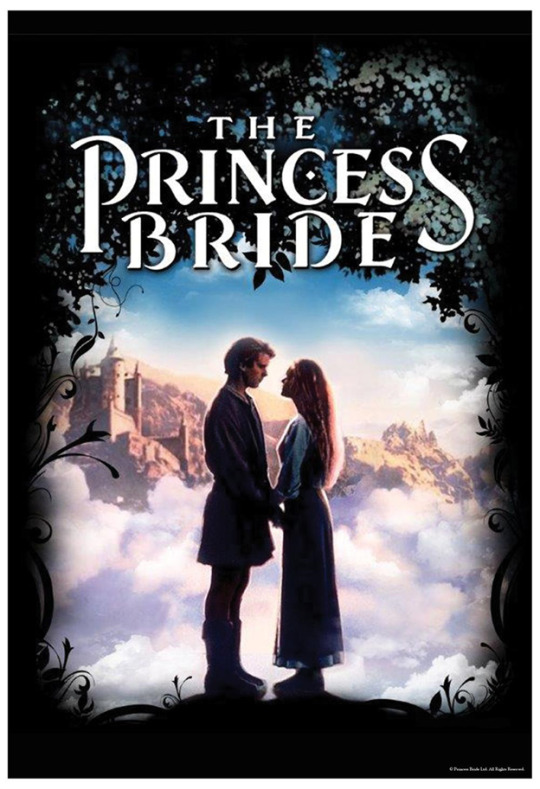
The Princess Bride is a film about a boy who is sick in bed who’s grandfather comes to read him a story called the Princess Bride. Most of the film is the story of the Princess Bride with a few scenes separated from the story to develop the sick boy’s storyline. The Princess Bride is about the love story of Wesley and Buttercup. They are separated when Wesley must travel abroad to raise money so he can marry Buttercup but his ship is captured by deadly pirates and he is killed. After a few years Buttercup gets engaged to the prince of the land, Prince Humperdink, and though she does not love him she must marry him. Three outlaws (a Spaniard, a giant, and a short man) kidnap Buttercup and take her to Prince Humperdink’s rival country to kill her and start a war. This is where the Dread Pirate Robert comes in and stops them in three different tests: one of skill, one of strength, and one of wits. The pirate reveals himself to Buttercup as Wesley but they are eventually caught by Prince Humperdink and Wesley is carted off to be tortured as Buttercup is to be wed. It is here where the Spaniard, who is on a journey to avenge the death of his father, and the giant, who is great friends with the Spaniard, come and rescue Wesley from the Pit of Despair. They revive him using a miracle pill and storm the castle to stop the wedding. While they storm the castle Inigo, the Spaniard, finds his father’s murderer and kill him and Wesley rescues Princess Buttercup from Prince Humperdink’s clutches and the heroes all ride off into the sunset to live a happily ever after.
This film follows the classic Hero’s Journey in a much more conventional way when compared to The Holy Grail. It humanizes the heroes instead of presenting these caricatures of the classic hero tropes. This allows them to be more relatable to the viewer. The narrative uses dialogue to draw the viewer in a lot as many of the scenes contain the characters doing not much else but talking. It very much reflects the grandfather reading the story to his grandson, he does not act out the scenes but sits back and narrates. The film, while containing plenty of action, finds its stride in these moments and the perfect reflection of that is a scene in which a battle of wits commences.
youtube
The battle contains no actions that a regular battle would and yet the tension is still very noticeable for the viewer as we are put in Vizzini’s shoes and do not know which cup has the poison. Wesley later reveals that both cups were poisoned and he had developed an immunity to it over several years of training. He had indeed bested Vizzini in the battle of wits. The viewer and Vizzini focus solely on the cups and do not begin to think that something else might be at play here. Vizzini is defeated due to his hubris which most classical villains will also fall for. But it is in the dialogue where the narrative becomes more evident.
Another scene in which the battle of the words overcomes the battle of the swords is at the end where Wesley confronts Prince Humperdink.
youtube
He is unable to stand for very long periods of time much less fight with a sword. However, he gives the appearance that he can defeat him through usage of language and this allows him to defeat his foe without throwing a single blow. The narrative reflects how the story is being told in the film. Everything takes the smarter solution over the stronger, much like how the grandfather will tell the story and not show.
Conclusion
Metz wrote “the semiotics of the cinema can be conceived of either as a semiotics of connotation or as a semiotics of denotation,” and these two films show what happens when you take the polar extremes of both. The Princess Bride connotatively shows that not everything is as it seems while The Holy Grail denotatively presents the audience with the same message. The narratives are closely similar but the way they are executed are worlds apart. This shows how versatile and accommodating a narrative can be. Without the narrative these films would both be dramatically different but because they share similar narratives they can be compared as if they were mirror images of each other.
Discussion Questions
1. What movies are much more denotative that connotative?
2. What films have similar narratives but are very different as wholes?
3. What films have unconventional narratives?
0 notes
Text
Discussion Leader Presentation
In his essay “Some Points in the Semiotics of the Cinema”, Christian Metz discuses the importance of narrative in film and the evolution of cinema. Metz asserts that cinema has adopted many of the attributes of a language, due to the presence of this filmic narrative. As a result, both denotation and connotation must be accounted for when studying semiotics of cinema. Denotation is represented by the literal meaning of image or sound, while connotation is determined by components of cinema such as the style of film, genre, and symbolism. It is the connotative components of a film which makes cinema comparable to that of an art form according to Metz.
“To ‘speak’ a language is to use it, but to ‘speak’ cinematographic language is to a certain extent to invent it”
Cleo from 5 to 7

The film Cleo from 5 to 7 directed by Agnes Varda follows a young French singer Cleopatra Victoire as she awaits the results of her medical tests. Cleo’s mind is constantly drawn back to her illness, as she believes the diagnosis will be terminal stomach cancer, so much of her day is undercut by this lingering fear of bad news. The events of the day are rather plain, after visiting a fortune teller and eating with her maid, Cleo readies herself for a meeting with her lover. She also works on her music with her songwriters and later visits her model friend. Yet, in all of her interactions, Cleo seems unsatisfied with her companions and always manages to direct her thoughts back to her illness. It is also made clear how highly Cleo values her looks, as her narcissism is apparent. She is always worried about achieving a certain image that she believes others will find favorable. She wears a big blonde wig, and prefers to hide her real self in favor of an image she thinks others will prefer. But, when she meets a soldier named Antoine, her perspective seemingly changes as the two bond and form a real connection. Her real name, Florence Victoire is finally revealed, and she is no longer hiding behind her fantastical self, Cleopatra. The two go in to find out her test results together.
This film perfectly relates to Metz’s argument. Viewers follow Cleopatra in real time, and scenes which should be cut are not. The narrative of the film is mainly Cleopatra’s own narrative. There is only one major conflict in the film, the illness, truly made aware to the audience. Yet, with each interaction Cleopatra has, insight about her life and character is gained and viewers must build the narrative and reach conclusions concerning Cleo. Characterization is the mean through which Varda constructs the narrative, as opposed to a riveting plot.
This clip shows Cleo in her apartment, following a quick visit from her lover. She is dressed lavishly, wearing her pampered wig, extravagant robe and white slippers. She exclaims how she presents herself perfectly for him, as she tries to fulfill what she believes is his idea of female perfection. Cleo then complains how he doesn’t talk about her illness, even though she never brought it up. The entire scene connotatively shows her selfishness and childishness. The way the scene is shot embodies the mood of the entire film, which plays with time. Viewers are made to feel as though they are experiencing the hours with Cleo, which is an essential part of the narrative. The scene also implies that the maid is subordinate to Cleo, as she is framed off to the side and behind her. Her input aims simply to please Cleo, there is not a real relationship between the two of them. All these inferences are gathered from the way the Varda presents the scene to the audience. The tension and anxiety felt by Cleo is inflicted upon viewers, and her insatiable desire for a real connection with the people in her life dictates the feel of the movie. This anxiety that Varda focus on can be seen in the following clip.
The scene with Cleo walking down the street shows viewers Cleo’s perspective of all of her onlookers. With only the sound of her heels in the background, the scene connotatively feels tense and ominous, as all these intense stares feel unwanted or suspicious. Yet, this is supposedly what Cleo desires as she seeks to be an object of desire. It may also be that Cleo is self-conscious and feels as though everyone is looking at her. This would explain the cuts to the people in her life seen throughout the film, including the maid and her lover. Cleo is always thinking about her perception from others, so it feels as though all eyes are on her. Especially when she has her wig off, Cleo may feel especially self-conscious. Varda pictures very little on screen, and adds a single sound, yet so much insight can be gathered. This the inventive nature of a filmmaker that Metz refers to, as Varda makes the narrative of Cleo from 5 to 7 come to life.
The Goodfellas
“In American gangster movies where, for example, the slick pavement of the waterfront distills an impression of anxiety and hardness (significate of the connotation), the scene represented (dimly lit, deserted wharves, with stacks of crates and overhead cranes, the significate of denotation), and the technique of the shooting, which is dependent on the effects of lighting in order to produce a certain picture of the docks (signifier of denotation), converge to form the signifier of connotation. The same scene filmed in a different light would produce a different impression.”
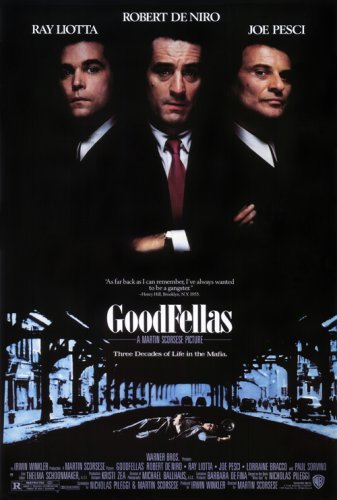
The story of Henry Hill, an Irish-Italian American who becomes part of New York’s Italian Mafia. The film follows his life as he works his way up through the ranks and begins to enjoy a lavish lifestyle filled with money, drugs, and crime. Much like Cleo from 5 to 7, the film highlights the journey of a single character and their individual progression. The narrative is constantly expanded upon and the film is shot in a life-like manner, as the development of characters is fundamental. The following scene demonstrates the tone of the film which centers around the idealized mafia lifestyle.
youtube
This iconic scene creates so much tension as the uncertainty associated with being a part of the mafia is portrayed. There is a feeling of unpredictability throughout the film, as Scorsese creates this narrative defined by self-interest and ambiguity to keep the audience unsure of every character’s next decision. Everything about this scene adds to the overall presentation of the mafia. They are all in their nice suits, in a dimly lit restaurant, with liquor bottles scattered across the table. The atmosphere created by Scorsese in this film highly differs from the one created in Cleo from 5 to 7. Rather than the narrative focusing on a pompous, self-centered singer who is troubled wither illness, the story is about the intense life of the mafia and its accompanying lifestyle. The following scene shows follows Henry as he takes Karen out for the first time.
youtube
This scene has a similar concept to the walking scene from Cleo from 5 to 7, yet the atmospheres are so different because they represent such different narratives. Both movies immerse viewers into the life of the main character, and you are given a sense of their day-to-day activities.
Discussion Questions
1). What other similarities between cinema and language can be drawn, other than denotation and connotation?
2). Can you think of any films where the narrative focuses upon the progression of a single main character and viewers are immersed into their lives?
3). How are directors able to make fictional narratives very life-like and real for the audience?
0 notes
Text
Discussion Leader Presentation: Ideology and the Practice of Sound Editing and Mixing
“Ideology and the Practice of Sound Editing and Mixing” by Mary Ann Doane explains how, just like the images, sound in film conveys the story and tone. Sound mixing doesn’t get the respect it deserves for it’s ability to immerse an audience and provide information in a way that complements the visuals. Although there is a norm in Hollywood for sound, it’s not an exact science. Mixing is more difficult to analysis than cinematography and mise en scene because sound causes emotions and knowledge in a way that is different from video. Mixing is therefore not just about providing information, but making sure it is aligned with the what the screen gives viewers. Sound is what reinforces the ideas of visuals.
This is mainly done through sound effects and music. Without being distracting, these two must give the audience a greater sense of the world around them, and the tone of each scene.
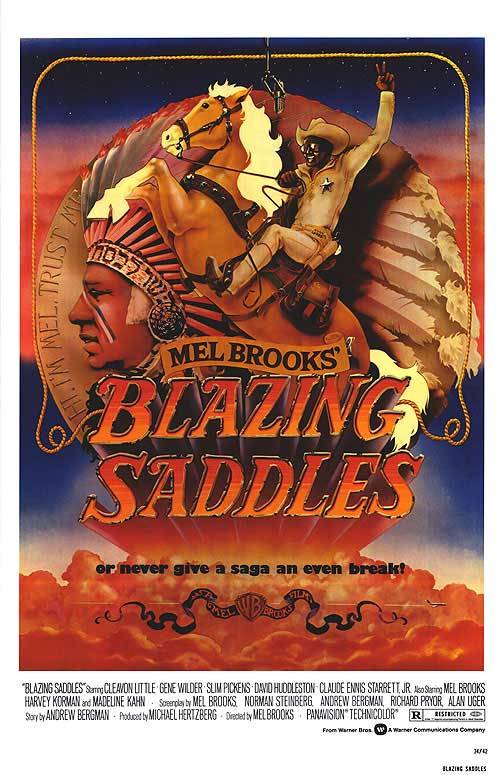
This famous Mel Brooks comedy tells the story of a black man in the wild west who is appointed as sheriff of a small, racist town. This premise is a serious and complicated, but the movie finds a way to make all conflicts seem silly and less severe. The sheriff wins the trust of the town by saving them from several ridiculous situations in equally ridiculous ways.
The comedy comes from the timing of each joke. Mel Brooks’ style is to take a scenario and slowly show the audience more and more weirdness as the scene progresses. As a master film maker, each reveal is met with a change in the sound that reinforces how out-of-place each addition is. What would normally be a serious plot quickly loses all its stakes because the audience has no choice but to give up on any chance of realism. Cartoonish sound effects and absurd dialogue turn every scene into nonstop waves of comedy.
youtube
A scene of outlaws being recruited into a gang becomes increasingly strange as the cowboys change into different villain archetypes, each accompanied with their own theme music. The changes in music become their own jokes.
youtube
This scene of a town being pillaged has a narrating theme song that makes the violence feel like a children’s book. Lines like “Well that’s the end of this suit.” turn the violence into a slapstick comedy, because this movie knows what it is and has no intention of taking itself seriously.

While this film also focuses on the struggles of a black man in the old west, Django Unchained is an gritty, action thriller that delivers a completely different tone. The film follows a slave named Django who is purchased by a bounty hunter who need Django’s help to kill his former slave drivers. The two strike a deal where Django will help Dr. Schultz in return for his freedom and help in freeing his wife.
The film is undoubtedly more realistic and serious in its depiction of the setting, and is famous for not holding back on the racist behavior of the time. However, this is not a drama. The action sequences are thrilling with fast-pace. Watching Django defeat several villains at a time is exciting to the point where you almost want to cheer him on. The gritty action is mixed with spaghetti western sound effects that make every fight more intense. The music gives off a triumphant feel to each fight, and at times seems like a music video. The movie even has comedic moments when Django and Schultz are together. Their banter often have no music in the background, making the dialogue feel like a normal chat between two friends. These moments are used to lighten the darker and more intense events.
youtube
Django’s revenge on his former slave drivers puts audiences on the edge of their seats. His entrance makes him look like a superhero, saving the beaten slave. Watching him kill the brothers feels satisfying, despite being so gruesome. The following exchange with Schultz turns the scene on its head, as the final killing has a fun banter between the two, to intentionally contrast their feelings from what is going on.
Mary Ann Doane explains that sound can generate feelings and provide information that complements what’s on screen. It contributes to the tone of each scene and influences how audiences feel about events. Much like video editing, audio editing is its own art form that is carefully done to improve the film as a whole. While it is important to recognize the skill and benefits of quality sound mixing, the best mixes are the ones that feel natural and seamlessly connect with every other aspect of the film.
Discussion Questions
1. What are some examples of times audiences are provided with information through sound and music, as opposed to seeing something on screen?
2. When has changes in music signaled or aligned with a change in tone or plot?
3. Have you ever watched a movie with poor sound mixing and sound editing that took you out of a film?
1 note
·
View note
Text
Ideology and the Practice of Sound Editing and Mixing
“It has become a cliche to note that the sound track has received much less theoretical attention and analysis than the image. Yet the cliche is not without truth value and isolates, but leaves unexplained, a fact. This lack of attention indicates the efficacy of a particular ideological operation which is masked, to some extent, by the emphasis placed on the ‘ideology of the visible.’ While it is true that, as the expression would have it, one goes to "see" a film and not to hear it, the expression itself consists of an affirmation of the identity (i.e., wholeness, unity) of the film and a consequent denial of its material heterogeneity. Sound is something which is added to the image, but nevertheless subordinate to it-it acts, paradoxically, as a ‘silent’ support.”
In “Ideology and the Practice of Sound Editing,” Mary Ann Doane explains how sound is an abstract aspect in a film that isn’t noticed quite at first but nevertheless adds a whole new experience to the film.
I will talk about the movies City Lights and Inception. Because they are both so different, I wanted to compare similar aspects of sounds in both films and to show how different they are presented due to the films being created nearly 80 years apart.
CITY LIGHTS (1931)
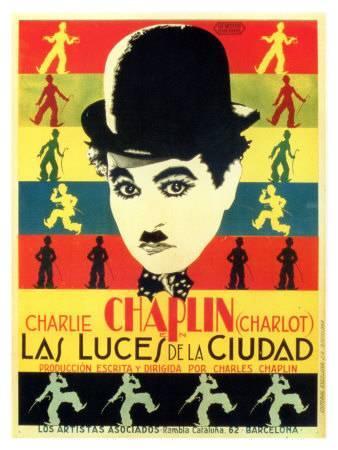
A Tramp, Charlie Chaplin, wanders the streets and comes across and beautiful woman selling flowers by the sidewalk. When approaching her, he realizes she is blind but he falls in love with her looks and purity. Throughout the film he keeps meeting with her and pretends to be wealthy, with the help of his alcoholic millionaire friend that he saved from suicide, and he buys the woman flowers and pays for her rent and gives her money for her to cure her blindness. Time passes and once she gains sight, she becomes an owner of a successful flower shop. The Tramp stumbles across the shop and see the woman in the window. She approaches him and as she hands him flowers she touches his hand and realizes he is the man that helped her before.
youtube
This is the scene where the Tramp and the Flower girl meet. The music is very soothing and romantic which foreshadows their relationship. The music also goes along with the girl’s purity and kindness. It is a very gentle scene and the music
Because this is a silent film, it was important to focus on the sound and music being played. Nowadays, sound effects are recorded off the screen, as we will see in Inception, and then they are put into the film. In City Lights, however, Charlie Chaplin used music to create and achieve these sound effects. It is very interesting how not hearing the sound effect of everything going on did not take away from the film. Charlie Chaplin made sure to create sound that went with the scene in order to keep the audience entertained and engaged. This can be seen in the following clip:
youtube
In this scene, almost everything has a “sound effect” through the music playing in the background. If not from the music, the sound is created by an instrument. From the steps that Charlie takes down the stairs to when he tilts his hat and sits down to smell his flower, music is used to create these sounds that go along with the tone of the scene. As the first man is getting back to tying the rope to the heavy rock, the music becomes very quick and intense. The music signifies how the action going on in the scene is dangerous and that something bad is about to happen. This music stops very suddenly as soon as Charlie’s character stops the man. When the big rock is dropped on Charlie’s foot, there is music that creates the sound effect of him being in main. The music changes to a calm happy melody as Charlie’s character starts talking about how wonderful life is and how “tomorrow the birds will sing.” The music changes a lot throughout this scene portraying the different effects going on. There are sound effects for whenever they both fall into the water which is portrayed with a xylophone. The music in this scene portrays every action happening and you can almost just listen to the song without watching and know what is happening.
INCEPTION (2010)

A professional thief, Leonardo Decaprio, steals secrets and other information from others by infiltrating their subconscious. He is given the opportunity to clear his record but he must complete an impossible task: “inception.” This is the implantation of one person’s idea into someone else’s subconscious. The characters of this film go through several levels of the target’s subconscious creating dreams within dreams to achieve “inception.”
This film is known for its many affects, on and off the screen. Its editing techniques and camera angles are all very unique and so is the sound. This film won an Academy Award for Sound Editing in 2010. Richard King is the sound editor and in this video, he explains some of the aspects that went into making the sound for this film and other techniques he used to achieve the sound he wanted.
vimeo
It is interesting the different levels sound can go into and how much work needs to be put in nowadays to achieve such sound effects. Watching how theses sounds are created makes the you think how much of the film was shot separately for the sound effects to be created and it makes you appreciate what the film offers. It’s things like this that you don’t really notice when you’re watching the film which is what Mary Anne Doane talks about, “one goes to ‘see’ a film and not to hear it.”
youtube
If you listen closely, the background music being played in the second clip is very high tempo signifying that the characters are in a rush and they have no time spare. The music allows for the audience to feel the high impact of the scene and gets them on the edge of their seats as the action continues. The music playing isn’t very loud but it still adds an important element to the action happening. In “Ideology and the Practice of Sound Editing and Mixing” Marry Anne Doane quotes Earnest Walters The Technique of the Film Cutting Room:
“Music is used to create an atmosphere which would otherwise be impossible. Just as the sound editor assembles his sound effects to create an almost musical effect in some sequences, so the music composer creates the instrumental background, to become at times an additional sound effect in itself. Often, it is an augmented effect blending with a dialogue scene so that one is, almost unaware of its musical presence, yet adding so much to the value of the scene.”
Soundtrack is also a very important element in films. Music allows us to make outside connections to film and the soundtrack makes scenes more memorable for the audience.
youtube
In my opinion, this scene is very memorable because there’s almost no dialogue and the music is playing very loud which stands out to the audience. The music in this scene goes with the rest of the film and even though it is the end, the song still adds suspense which of course leads to the cliff ending.
“The effacement of work which characterizes bourgeois ideology is highly successful with respect to the sound track. The invisibility of the practices of sound editing and mixing is ensured by the seemingly-‘natural’ laws of construction which the sound track obeys.”
-Mary Ann Doane
Conclusion:
Even though both films portrayed different types of sound effects, it is interesting to see how sound can be used in both situations where technology is not available and where it is. It allows for the audience to appreciate the time and work sound editors put in to create such sound effects and scores for the film.
Discussion questions:
1. What effect does sound have on your viewing experience? Are there certain aspects that negatively influence film and the viewing experience?
2. What songs do you associate with scenes in films or just the film in general? What made this scene/song stand out?
3. Are there certain sound effects that are more noticeable or stand out in a film? Are there any “famous” sound effects?
example: https://www.youtube.com/watch?v=oeN-jDGQlpQ
0 notes
Text
DISCUSSION LEADER PRESENTATION // THE DRAMATURGY OF FILM FORM
In “The Dramaturgy of Film Form”, Sergei Eisenstein discusses the nature of art as well as its purpose and specifically addresses the theory of montage, asserting that it should be used to further the narrative or suggest an underlying idea rather than simply to depict a succession of sequential events.
This methodology can be applied to West Side Story (1961) and Dirty Dancing (1987) in several respects.
WEST SIDE STORY

West Side Story follows the forbidden romance between Tony and Maria who are affiliated with warring gangs, the white Jets and Puerto Rican Sharks respectively, as mayhem ensues in typical Romeo and Juliet fashion.

“FOR ART IS ALWAYS CONFLICT
Because of its social mission…
It is the task of art to reveal the contradictions of being. To forge the correct intellectual concept, to form the right view by sitting up contradictions in the observer’s mind and through the dynamic clash of opposing passions.”
~Sergei Eisenstein
According to Eisenstein, one defining aspect of art is its ability to provide social commentary. This is clearly evident in West Side Story’s “America” number which contains lyrics modified from the stage version in order to more accurately depict the oppression and racism faced by Puerto Ricans in America.
This is ironic given that of the main Puerto Rican characters-Maria, Anita, and Bernardo-only Anita is actually played by a Puerto Rican actor, Rita Moreno. By no means is it is a perfect commentary but it does make an effort to depict the negative impacts racism has on immigrants as well as the senselessness of the conflict between races.
youtube
“Montage is not an idea composed of successive shots stuck together but an idea that DERIVES from the collision between two shots that are independent of one another.”
~Sergei Eisenstein
Eisenstein’s article also addresses montage, making the distinction between combining shots together simply to show succession and contrasting shots in order to create a greater meaning. A straightforward visual and temporal montage is evident in “Tonight Quintet”, the number leading into the rumble between the Jets and the Sharks that will ultimately result in two deaths and a more concrete rivalry between the two gangs. Juxtaposing the perspectives of the gangs, the lovers, the police, and others adds to the climactic tension of the scene and shows how many people will be greatly affected by the violence.
youtube
DIRTY DANCING
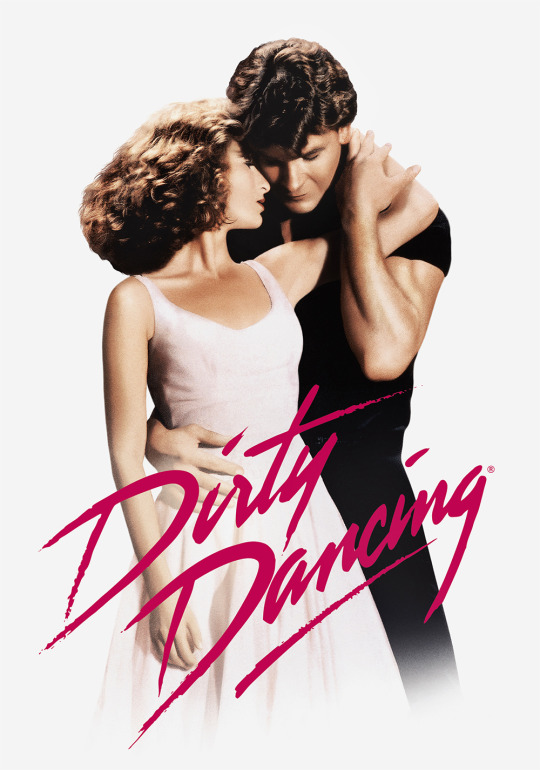
In Dirty Dancing, Baby Houseman joins her family at a summer resort where she and dance instructor, Johnny Castle, fall in love despite the forces pulling them apart.
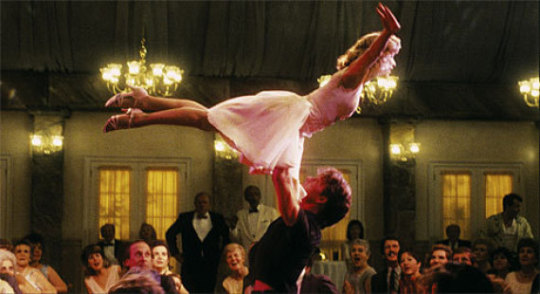
One could apply the social commentary theory to Dirty Dancing through the inclusion of the abortion subplot. The portrayal of Jenny’s abortion has been described by author Yannis Tzioumakis as offering a “compassionate depiction of abortion in which the woman seeking an abortion was not demonized with the primary concerns being her health and preserving her capacity to bear children at a future time rather than the ethical dilemma that might or might not inform her decision, a portrayal that is not necessarily available in current films.” In this sense, the film is fulfilling its role by conveying a social message.
youtube
“Shot and montage are the basic elements of film.”
~Sergei Eisenstein
A more typical example of montage is the dance training sequence between Johnny and Baby. However, unlike other training montages that simply use the medium to shorten a realistically long period, for instance, condensing the journey from amateur to an expert into a matter of minutes, Dirty Dancing’s montage shows more gradual improvements and maintains a more realistic progression of their relationship as well.
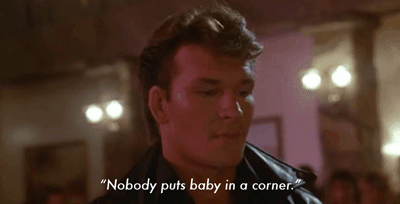
“Because: the limit of organic form (the passive principle of being) is NATURE. The limit of rational form (the active principle of production) is INDUSTRY and: at the intersection of nature and industry stands ART.”
~Sergei Eisenstein
Additionally Eisenstein’s theory can be applied in a sense simply to unexpectedly brilliant improvised scenes-that is, the intersection between reality (the actors interacting organically) and production (the actors embodying their characters on film). Several classic scenes in Dirty Dancing were created through this blend of nature and industry.
youtube
DISCUSSION QUESTIONS:
What are some ways that montage can accomplish more than a series of successive shots?
What are some films that successfully use the form to subtly make social commentary?
What are other classic scenes from movies that were improvised-in other words, created from the intersection of science and industry?
1 note
·
View note
Text
In Vsevold Pudovkin’s “On Editing,” he discusses how editing is essential to creating the overall meaning in a scene. By this he means clips should be edited in a way to guide the viewers into what they see which should further creates the narrative as a whole. This editing technique is prevalent in the films Flashdance (1983) and Immortals (2011)
Flashdance

Synopsis: Alex Owens, who is played by Jennifer Beals, works a day job in a steel mill, but at night she dances in a bar. She later finds out that her boss at the steel mill sees one of her performances is seeks interest in her. He questions why a beautiful woman would be working in a steel mill, and he becomes supportive of her dancing career. She later continues her efforts to get accepted into a prestigious dance conservatory. While she is terrified of failure, she gets continued support from her boss.
This film using montage is used simply because Jennifer Beals uses a body double in all of her dancing sequences.
youtube
youtube
Pudovkin discusses how editing is used to make a film come together as a whole in order guide the viewer’s eyes into seeing something that creates the overall film meaning. This can also be seen in the film Immortals.
Immortals

Synopsis: King Hyperion and his army march across Greece in order to find the Bow of Epirus. He wants this weapon because it’s invincible and he can cast the gods out of Mount Olympus and become master of the world. A stonemason named Theseus shows the words of the sibylline oracle, who is played by Freida Pinto, who convinces him that he is the key to stopping the king.
This film also uses montage style editing in order to manipulate viewers because Freida Pinto has a sex scene that uses a body double.
youtube
In conclusion, montage style editing is not always used in order to create deeper meanings in a film. It is all about manipulating the viewers emotions and creating illusions for them to see what the filmmakers want them to see.
Discussion Questions
1. What other films do you know that have actors and actresses that use body doubles?
2. What films use montage in order to manipulate what the viewer sees whether it’s to evoke certain emotions, or any other reasoning?
3. What are other ways that pieces of cinematography (lighting, sound) are used in order to manipulate the viewer and is it done effectively?
0 notes
Text
Discussion Leader Presentation, Vsevold Pudovkin “On Editting”
Molding Experience Through Editing
“The guidance of the attention of the spectator to different elements of the developing action in succession is, in general, characteristic of the film” - Vsevolod Pudovkin
Editing is a characteristic of film that cannot be replicated by any other visual medium. It allows for the film creator to shape and guide the experience of the viewer by revealing what is necessary for them to see, or by hiding certain elements in order to create suspense or mystery. Vsevolod Pudovkin explains and elaborates on the process of editing in his paper titled “On editing.” In this paper he states…
“One must learn to understand that editing is in actual fact a compulsory and deliberate guidance of the thoughts and associations of the spectator. If the editing be merely an uncontrolled combination of the various pieces, the spectator will understand (apprehend) nothing from it; but if it be co-ordinated according to a definitely selected course of events or conceptual line, either agitated or calm, it will either excite or soothe the spectator.”
The movies The Big Sleep by Howard Hawks is an excellent example of this, as the editing in the film guides us through the exciting and suspenseful detective narrative. On the otherhand, in order to create an experience that is the polar opposite of what is taken from The Big Sleep, Hail Caesar by the Coen Brothers uses its editing to guide the viewer into a satirical, comedic detective narrative. The different uses of editing turn each of these detective movies into entirely polar experiences.
The Big Sleep

The Big Sleep by Howard Hawks features private detective Phillip Marlow, who is hired by General Sternwood to help with a blackmail case involving his daughter Carmen. As the case develops, Vivian, Sternwood’s older daughter aids Marlow, but also makes the case more complex as originally conceived. After a series of murders, betrayals, and close calls, the movie ends with Marlow and Vivian in each other’s arms.
The editing in this movie follows, almost exactly, the same steps that Pudovkin describes in his thesis. Each object and character that the director needs the audience to see is shown.
youtube
The first shot shows the name of the house, and pans to show the doorbell that Marlow is pressing. Then, in the following encounters with the butler, Carmen, and the General, the editing puts focus on whichever character is more important to view, whether it is because they are speaking, or reacting to something that has just been said. With the General however, there is something specific to note. Neither of the characters are moving, and the cuts maintain a 180 degree viewpoint, focusing on each character when they are talking or reacting. However, as the conversation continues on, getting more serious and in depth, the camera moves in closer to each character each time it cuts to them. This mimics the action of the third person, which is the audience, closing in. The act of closing in on a conversation or event is caused by deep interest or focus. Now, Pudovkin states in his thesis that “There is a law in psychology that lays it down that if an emotion give birth to a certain movement, by imitation of this movement the corresponding emotion can be called forth.” Therefore, this replication of a person moving in closer to the conversation calls forth the emotion of deep interest of the audience, pulling in the audience into the narrative.
These editing effects and techniques can also be observed in a scene of which Marlow is in his car just outside of Geiger’s house. He hears a gunshot, and a woman screaming. The scene also shows bright flashes, and quick cuts as Marlow reacts to this event and acts quickly breaking in. These quick cuts each show each element of the scene: the car, the house, Marlow, the bright flashes, Marlow running, and the door breaking open. Cutting to these images in such a quick manner is similar to a viewer looking back and forth after each event takes place, demanding their attention, and causing a slight adrenaline rush.

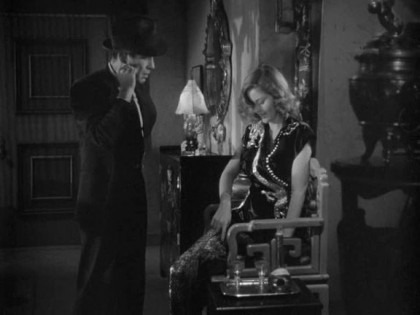
The way The Big Sleep is edited makes the actions scenes seem more high paced with its quick cuts and specific focus, while also making the dialogue heavy moments more intriguing by using cuts that put a character’s reactions and words into focus.
Hail, Caesar!
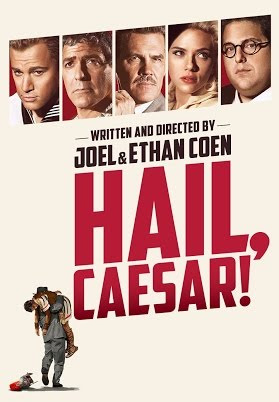
Hail Caesar, is a film by the Coen brothers that features several plots that intertwine and collate to form one main plot. The main plot is that Baird Whitlock, the studio’s lead actor for an upcoming epic, gets kidnapped by the communist party screen writers; and it is the job of Eddie Mannix to get Whitlock back while handling all the other problems that the studio faces. One thing happens after another, and eventually Whitlock gets saved by another actor. This movie isn’t exactly a detective movie, however it has a main character that acts as Marlow does in The Big Sleep and who is also trying to solve a mystery. This movie plays as more of a satire to Hollywood, and is presented as a comedy as opposed to the serious tone of The Big Sleep.
The editing of Hail Caesar also follows the ideas that Pudovkin writes about, with the audience being guided by the film by having the cuts reveal what is important, and acting as a third person in the scene. This scene where Mannix is handling a pregnancy scandal with a studio actress demonstrates how through editing only, the entire tone of the scene is changed.
youtube
The acting and setting of this scene is very similar to the scenes that are displayed in The Big Sleep; however, the editing is the only thing that is different. In The Big Sleep, each conversation would have a shot-reverse shot style of cuts that display those that are speaking. In this scene, the focus of the scene is not the conversationalists, but between the odd attraction between Scarlett Johansson’s character and Jonah Hill’s character. This is a deviation between auditory and visual focus that is not seen in The Big Sleep; this kind of deviation is what adds a comedic factor to the movie, even though everything else is similar.
Even though Hail Caesar is comedic in nature, it uses its editing to create more serious scenes as well. The following scene uses Pudovkin’s techniques further to create such an effect.
youtube
This scene starts off like the many other conversations that are seen in both The Big Sleep and Hail Caesar, however once Mannix gets up to manhandle Whitlock things change. Every action receives two cuts, one showing Whitlock, and one that shows Mannix, which doubles the effect of every action. It stills follows what Pudovkin states in his paper by showing the audience what they need to see; which is the stern face of Mannix, mixed with the panicking face of Whitlock. These cuts reveal to us how each is reacting to the dialogue in a serious manner, but with a series of cuts that make it seem like it is full of action, like with the car scene in The Big Sleep.
Conclusion
With both The Big Sleep and Hail Caesar having similar plots, similar mise-en scene, and straightforward cinematography, it is up to the edisting to differentiate the two movies. While the prior contains edits that provide a serious, action packed, and intriguing movie, the latter contains edits that invoke a sense of comedy. The two movies contain the same editing techniques and rules laid out in Pudovkin’s “On Editing”. The key difference is simply how they are used to change the focus and mental reactions to the viewer.
Discussion Questions
1. Pudovkin’s methods of editing that he discusses in his paper are meant for a more straightforward style of storytelling, where each detail is shown and easily organized. What are some other styles of editing that can either create the same straightforward effect, or create a more surreal experience?
2. The differences in tone of the two movies discussed can be attributed mostly to the different styles of editing. Are there other movies that are similar, but feel different because of editing? What are they?
3. Do you think that all movies can have a change in tone simply from the way it is cut together? Why or why not?
0 notes
Text
Discussion Leader Post: Active and Passive Gaze
A common complaint about Hollywood is the lack of female characters who aren’t damsels in distress; It seems like for every single movie with a female lead there’s a hundred more with male leads. This is being changed though, and there is a current trend for movies to have a lead female character now; This is, unfortunately, a deceptive figure. Even though women protagonists are on the upswing, many of these characters are damsels in disguise. Today I will be discussing two films with female leads that are pushed to the background by their male co-stars: Alien and Rogue One.
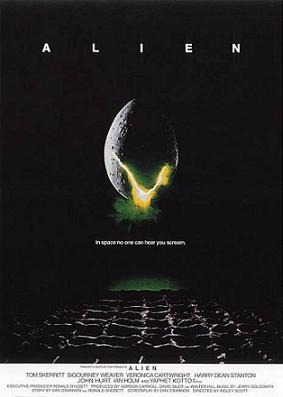
In Alien, the crew of a commercial ship called the Nostromo are woken up early when a mysterious signal is picked up. They go out to investigate where the signal came from, and one of their crew members is attacked by a strange alien that attaches to his face. They bring him back onto the ship, and all hell breaks loose when a baby alien bursts from his chest and escapes onto the ship. All the crew is picked off by the alien except for Ridley, who manages to destroy the ship and get out on an escape pod. When she finds the alien on board her pod, she shoots it out through the airlock and burns it up with the thrusters.
Alien is often hailed as a feminist icon, with Ripley being the main Action Girl who kills the alien and saves the day. However, watching over the movie shows that the male gaze is heavily influencing how each shot is made. Throughout the first part of the film we see Ripley constantly talked down to and frequently ignored in favor of other opinions. In the scene where she tries to uphold quarantine and follow procedure, nearly every other person disagrees with her actions and she is overruled by the science officer. When speaking on the dangers of keeping the alien corpse on board, the captain favors Ash’s decision over hers with barely any argument. She is mainly in the scene to be a dissenting voice, and it is no better than if she didn’t speak up at all.
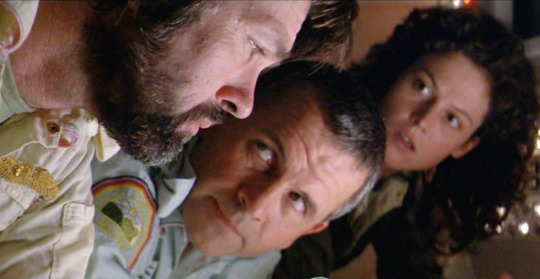
Another issue to look at is her lack of active decision-making throughout most of the film. During the initial encounter with the facehugger and the subsequent attacks from the alien, the male characters perform most of the action while Ripley and Lambert are relegated to background pieces. Ripley is caught off-guard by the dying facehugger and is shielded by Dallas while Ash studies it; When Ash finally turns on Ripley for discovering his orders, she is helpless to defend herself until Parker arrives to save the day. In fact, the only time Ripley has meaningful actions is when everyone but her is dead; This is called the “Final Girl” trope, and it was a common theme in horror movies at the time. This is not to say that Ripley is a weak character, but instead that the film highlights the actions of the men more than the women.
youtube
Mulvaney speaks of two kinds of pleasure in looking, the active/male and the passive/female. The male cannot bear the burden of sexual objectification, so he instead must take an active role to move the story forward. In contrast, the female displayed functions as an erotic object for the characters and an erotic object for the spectators in the audience. The other characters must defend Ripley and Lambert from the threats that they face, and they are pushed to the background in most scenes. The passive role is stronger in Lambert’s character, as she cries and is helpless against the alien when it takes her. Meanwhile, the men are the ones who fight the alien and make many of the plans to capture it, controlling the power of every scene; the spectators identify with them and they dominate the shot because of it.
youtube
As for the “erotic” aspect of Ripley’s character, there is one scene that clearly identifies this role to the spectator. As she leaves the explosion of the Nostromo in the escape pod, she prepares herself for the cryo-chamber by stripping down to her underwear then operating all the necessary switches. Before this there was no need for fetishizing, as she was relegated to a background object to be protected and there were men around to bear the active gaze of the spectator. Mulvaney talks about how the female figure can evoke a threat of castration to men, the active controllers of the look. This is offset by the substitution of a fetish object or turning the figure into a fetish to make it reassuring rather than dangerous. Ripley is shown here erotically so the male gaze isn’t offset by her suddenly active role near the end, threatening the balance of power in the movie.
youtube
For comparison, I have chosen the movie Rogue One. In Rogue One, Jyn Erso and a ragtag group of rebels learn about a weapon called the Death Star being built by the Empire. Jyn’s father has sent a message stating he built a vulnerability in the Death Star that can destroy the entire ship, but the Rebel Council refuses to undertake such a dangerous mission. It falls to Jyn and her allies to take on the suicide mission, and they manage to transmit the plans before the entire planet is destroyed by the Death Star.

Jyn is the main character of the film, but is overshadowed by her male co-stars in many scenes; Cassian is the one who leads the action of the shot, while Jyn follows behind and helps. While she can clearly fight, she is often rescued or given orders by Cassian or her father. For instance, when the Death Star is destroying the planet Jyn is on she is too overcome with emotion from her father’s message to move. Cassian rushes in and Gerrera tells her to go with the Alliance and secure the plans for the Death Star; After this she’s led away by Cassian and escapes the doomed planet. The focus lies on the male characters as they take on the active role, relegating her as an object to be protected.
Another scene would be where Jyn is trying to encourage the Alliance council to take the Death Star plans from an Imperial base. She rallies them with a heartfelt speech, but is rejected and sent away; Then Cassian comes by with a small army and tells her he’s willing to fight by her side. His actions have meaning that push the story forward, while Jyn is dragged along for most of the film and acts as a helper at best and an observer at worst. This further connects to the idea of the burden of active gaze on the male character, which the spectator connects to.
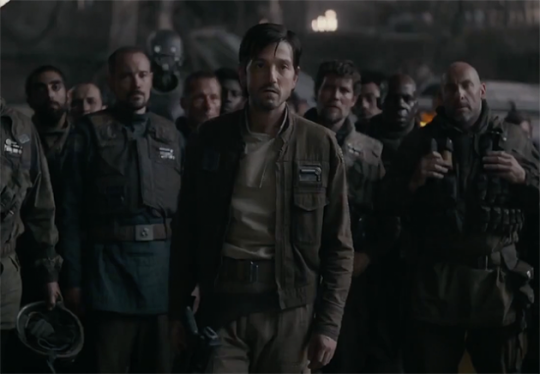
This can be seen at the end of the movie as well, where Jyn desperately tries to send the plans for the Death Star to the rebel forces. She is held captive by General Krennic at the top of the tower, with no visible way of stopping him on her own. Enter Cassian, who rescues her by shooting Krennic and leading her away; then they sit on the beach together and watch as the Death Star detonates the planet. She is rescued from her position by Cassian (the bearer of the active gaze) and follows his orders even when he is clearly the one needing support. She is his possession, and though it is left ambiguous the ending implies that she has grown feelings for him as well. This further solidifies her passive position and makes her something to be won or earned.
youtube
In summary, both movies have strong female leads who are objectified and overshadowed by their male co-stars. The active/male and passive/female divide described by Mulvaney is present in many scenes, and the women are often in need of protecting and rescuing from dangerous situations. A feeling of domination is present, with the men having an overwhelming amount of power compared to women. Even if this is not intended, Mulvaney’s observations on male and female roles in cinema still hold up today.
Discussion Questions
1. What are other movies where the active/male and passive/female pleasure in looking are present? Is this trend ever reversed or ignored?
2.What are ways that these movies could be changed to avoid the objectifying of women?
3. Can movies affect how we see gender roles in our daily lives?
0 notes
Text
Discussion Leader Presentation
Laura Mulvey, “Visual Pleasure and Narrative Cinema”
Mulvey states that the function of a women in forming the patriarchal unconscious is two-fold. They stand as the “bearer of meaning, not the maker of meaning.” These issues are reflected in the psychoanalytic theory.
Scopophilia means sexual pleasure dervied from looking. One person using another as a sexual stimulation, just by looking. Fetishistic Scopophilia, the object it transformed into something satisfying in itself.
Pleasure from looking has been seen between males, as the active side, and females as the passive side. In other words, males are the ones experiencing pleasure from looking at women. Traditionally, the woman had two levels of function: an “erodict obejct” for either the characters withing the story or for the spectators. The woman is often shown isolated and glamorous, and often sexualized. She then falls for the male character, but becomes his property in a way; losing her glamour but still being seen as an object in his and the audience’s eyes.
Some Like It Hot
Saxophone player, Joe, and bass player, Jerry, witness a Saint Valentine’s Day Massacre by accident. They are spotted by the gang members and leader, Spats Colombo. With no money, no job and being forced to run for their lives, they take a job with Sweet Sue and her all-female band headed to Miami. They disguise themselves as women and take the names Josephine and Daphne. As they are boarding the train they see Sugar, singer and ukulele player. Joe and Jerry both develop a crush on Sugar. Sugar admits to Josephine, that she also gets the “fuzzy end of the lollipop,” because she always falls for saxophone players who break her heart. During the secret “party,” Josephine and Daphne become friends with Sugar. Once they reach Miami, Daphne meets Osgood Fielding, who seems to be very interested in Daphne. Meanwhile, Joe pretends to be a millionaire named Junior, hoping to impress Sugar. Osgood invites Daphne to his yacht, but Joe convinces Daphne to keep him away for the night so he can take Sugar on the yacht; where he pretends he has psychological trauma and he would marry the girl that would be able to “fix” him.

In this movie, we can see a lot of scopophilia. The movie opens with a men going into a hidden funeral party, where there is a group of girls dancing on stage. The men are sitting, drinking “coffee,” while watching the girls dance. Another example where we can see pleasure from looking is the first scene Sugar appears. She walks past Josephine and Daphne to catch the train. The camera is focused directly at her butt, and the men clearly staring.
Josephine and Daphne try to get close to Sugar to find out information, to later on impress her as males. Sugar’s dream man is wealthy, wears glasses because it means he will be “gentle,” has a yacht, a private island… In the past she has fallen for saxophone players, but gotten her heart broken every time.
When the girls arrive ta Florida, there is a line of men who were sitting outside the hotel waiting for them. Daphne gets a millionaire, Osgood Fielding’s attention. He follows her to the elevator where the camera waits outside. The elevator comes back down with Daphne screaming at Osgood, and slapping him across the face. The audience can assumed Osgood tried to grab Daphne when they were inside the elevator.
After Joe and Sugar’s night out in the yacht, Sugar has the “most perfect” dream. Where they drifted away in the yacht and Joe was the captain. Meanwhile, Sugar was the crew, in charge of cocktails and sorting Joe’s shells. She not only made herself do the “house chores,” but also making it sound perfect for her.
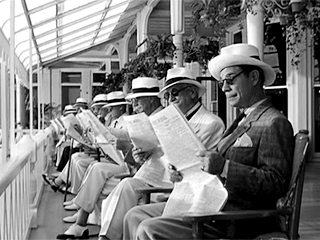
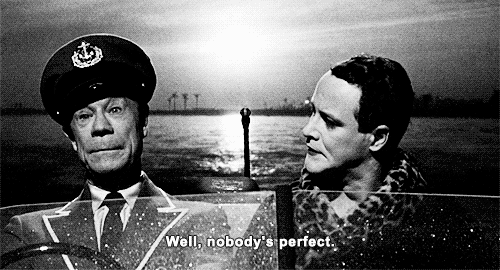
youtube
youtube
The Wolf of Wall Street
This film is based on the true story of Jordan Belfort, a nobody who rises to the top of Wall Street. He gets his first job from Mark Hanna who teaches him how to sell stocks. Due to the crash in 1987, he loses his job and is forced to start from the beginning. This is when he finds out a penny stocks, which give a 50% commission instead of 1%; they are trickier but he doesn’t care as long as he makes commission. He meets Donnie, and the two of them go into business together. A company that starts in a garage, becomes huge in Wall Street. They become filthy, and you can see in the film how money corrupts them. An article about him is published calling him the Wolf of Wall Street, which was meant to be bad publicity, but makes him more popular than ever. Belfort was married before everything happen, but she ends up leaving him. He develops a relationship with Naomi Lapaglia, and eventually marries her. The relationship doesn’t last too long in good terms, they start arguing daily and the relationship becomes mostly sexual. An FBI agent starts coming after Belfort, but he tries to outsmart him. Belfort and his dad agree that he should leave the company, but as he is giving his speech he decides to stay. It shows that yes, he is a fraud, but he is dedicated to his company and the people in it. They have to send the money out of the country, to avoid getting caught, therefore they use Naomi’s aunt and Brad’s Swiss girlfriend. Brad ends up getting caught and goes to jail. Donnie tries to distract Jordan from what happened so he offers him “lemons,” which take a while to kick in. It hits Jordan when he is at the country club talking to his dad on a payphone. In the meantime, Donnie is high at the house talking on the phone, which is tapped, with the Swiss banker. They end up leaving, running the company from the yacht. In the end, they end up arrested because the Swiss banker got caught doing other illegal activities.
The whole movie is very graphic when it comes to showing women. Jordan and his coworkers hire prostitutes while they are at work. It almost seems like they are never working, just spending the money. There is one sequence where Jordan describes the different types of prostitutes they get. For example, how much they cost, and what they should be worried about afterwards.
The first party Jordan throws, he is still married to Teresa but it is when he meets Naomi. The group of guys were doing drugs upstairs as Naomi walks in, and the decide this one is for the “Wolf.” Jordan hits on her while his wife is outside and her date is right next to them. Donnie, who is extremely high, comes downstairs and starts masturbating staring at her. He is literally showing an example of scopophilia.


Discussion Questions
1. What are some other examples of scopophilia (pleasure from looking)?
2. What are some other films where you can clearly see how women are objectified?
3. Do you think filmmakers nowadays are trying to move away from women being objectified in their films?
2 notes
·
View notes
Text
Discussion Leader Presentation: Cinematography
Cinematography and the Use of Point of View to Create Suspense
Cinematography is one of the main ways that a director can unconsciously evoke a certain feeling from the audience when watching a film. By using the technique of a restricted point of view, the cinematographers in both Alfred Hitchcock’s film Rear Window and Danny Boyle’s film 127 Hours are able to create different, but equally relatable, viewing situations based on how the main characters of the film feel about their respective conflicts. By limiting the point of view to only include the main character’s viewpoint, it makes it so the audience only has a much knowledge as the character, eliminating any possibility of dramatic irony and creating a sense of suspense and uncertainty.
“The use of different lenses, when not dictated by technical considerations aimed at restoring habitual perspective (such as shooting in limited or extended spaces which one wishes to expand or contract) does not destroy perspective but rather makes it play the role of the norm”. -Jean-Louis Baudry
Rear Window

In Alfred Hitchcock’s Rear Window, photographer L.B. Jefferies, or Jeff, is confined to his New York City apartment due to a broken leg and, presumably out of boredom, begins to watch his neighbors and their daily lives through the window. While watching his neighbor Mr. Thorwald, Jeff is convinced that he has seen him kill his bedridden wife. He enlists the help of Lisa, his potential love interest, and Stella, his in-home-nurse to piece together enough evidence to prove this man is a murderer without tipping him off in the meantime.
The most evident cinematographic choice in the making of this film was the use of a very small and limited setting. The entire film was shot within an apartment building courtyard from the perspective of Jeff’s window. Often times, the view was restricted even more, being shot through the eyes of his binoculars or the lens of his camera. This technique allowed for the audience to feel as though they were stuck inside the apartment with this main character. It also forces the viewer to sympathize with the fact that Jeff was extremely bored in this situation and understand why he spent the majority of his time watching his neighbors through their windows, an activity that in most other situations would not be appropriate.
youtube

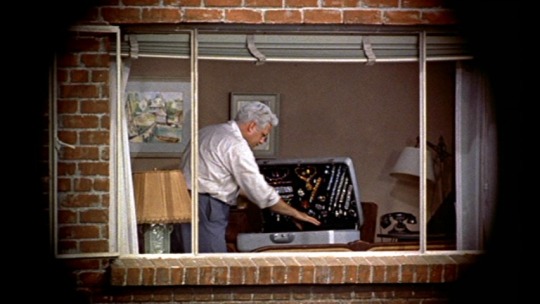
Another extremely effective technique that is used to make the viewer feel further confined to this small space is the brief contrast shown in Jeff’s photography collection. The camera slowly pans over photos that he had taken in the past of extravagant places and people, making the setting of the film seem even smaller and the environment seem more tense.
The fashion in which Jeff’s neighbors, especially the presumed murderer, were filmed only from the angle of his apartment eliminated the possibility of dramatic irony. In many thrillers, the audience often has knowledge of what is going to happen before it happens based on the fact that the viewer is watching from a “third party” angle. This does not usually allow for the viewer to feel as though they are a part of the film, disconnecting them from a sense of reality. In the case of Rear Window, the viewer only has as much evidence as Jeff does from what he can see through his window, giving a more suspenseful feeling since the audience also does not know for sure if Thorwald is actually a murderer. This allows the viewer to put faith in Jeff’s hunch that the visual evidence he is finding confirms Thorwald committed the murder, along with allowing the viewer to draw their own conclusions.
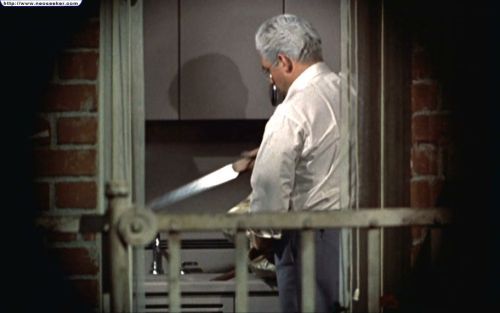

Even when Lisa breaks into Thorwald’s apartment, the point of view is not changed from Jeff’s window to show how the scene may have looked from Lisa’s angle. This was likely a deliberate choice when filming to allow the audience to feel exactly how nervous Jeff was feeling when someone he loved could be kidnapped by a murderer any second.
youtube
127 Hours
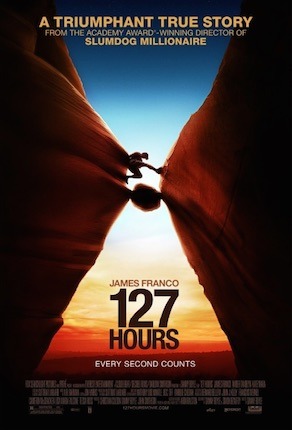
In Danny Boyle’s 127 Hours, based off the his real-life memoir, hiker Aron Ralston goes exploring in the mountains of California and finds himself trapped when a boulder falls on his arm. The movie chronicles his experiences in trying to escape the situation and how he survives in the meantime.
At the beginning of the film before Aron becomes trapped by the boulder and periodically throughout the film the director makes use of extreme wide angle shots of the scenery with camera panning to allow the audience to feel the contrast between the wide open space and the confined one that he is forced to spend several days in. This technique allows the audience to understand just how confined this space actually is. This deliberate cinematographic addition to the film further develops the idea of restricted point of view and makes it easier to empathize with the feelings of the character later on.

As soon as Aron gets stuck between the walls of the cavern and the rock, the camera angles immediately change from wide angles of the landscape to extreme close-ups of him from several angles. This cinematographic choice was most likely deliberate to force the viewer to feel as closed in as he was, rather than an outsider looking in on someone who is being trapped. During the scenes throughout the film where Aron was trapped, he was being filmed from up close even though there was enough room in the cavern for a wider angle shot of him from the front, the back, or from above. This choice of close-up angles and movement of the camera with Aron as he moved conveyed the tension he felt in the situation better than if he were to have been filmed from far away with a stationary camera.

Another way contrast is used to accentuate the restricted point of view that occupies most of the film is the use of flashbacks to happier times. Some of these flashbacks include pleasant memories in the wide open, mountainous terrain of California, as opposed to the closed in aspects of this same terrain that he experiences throughout the film. The fact that these flashbacks include the people that he loves adds to his need to escape the canyon but reinforces the fact that he’s stranded.
youtube
Another cinematographic technique used in this film to ensue a sense of isolation is the main character’s use of his camera to capture moments throughout the journey that perhaps nobody else would have seen otherwise. This use of poor quality visual shots and shaky camera handling makes the audience understand just how scared and alone the main character most likely feels.

“The spectator identifies less with what is represented, the spectacle itself, than with what stages the spectacle, makes it seen, obliging him to see what it sees”. -Jean-Louis Baudry
In summary, both of the aforementioned films make use of a restricted camera viewpoint to achieve similar effects for different reasons. While Rear Window creates suspense in order to highlight the uncertainty that the main character and the audience both share about the murder, 127 Hours creates suspense in the form of fear for main character’s life. Regardless of the motives behind the evocation of these emotions, it is evident that the cinematography of the camera angles showing the limited field of view in both of these films helped to transport the audience into the minds of the main characters.
Discussion Questions:
Besides restricted point of view, what are some other cinematographic or visual techniques used in film to create a sense of uneasiness or suspense?
What are some other films you have seen that include an isolated main character and do these films achieve the same suspenseful effect as Rear Window or 127 Hours or do they evoke different emotions? Explain why.
Do you think cinematography (camera movement/angles) is more or less effective in creating suspense than other aspects of filmmaking (set design, lighting, music and sound)? Explain.
0 notes
Text
Cinematography Discussion Leader Presentation
How Cinematography manipulates the audience.
Cinematography constitutes how a film is shot and presented. It contains tools of film making such as angle of filming, distance of a shot, and how shots transition between one another. These tools are used to create a wide range of effects in the audience when watching cinema. In The Third Man, a film by Carol Reed, the cinematography develops a foreboding and uneasy atmosphere in the crime-ridden streets of Vienna. Similarly, Funny Games, a film by Michael Haneke, uses long takes to maintain reality and brutality in his film which criticizes the state of entertainment. Overall, it is a film’s cinematography that dictates how it is perceived by the audience.
“Equally distant from ‘objective reality’ and the finished product, the camera occupies an intermediate position in the work process which leads from raw material to finished product.” -Jean-Louis Baudry
The Third Man

In The Third Man, the author Holly Martins moves to Vienna to work with his friend Harry Lime to publish medical writings. When he arrives, however, he finds that Harry is recently deceased. Suspecting foul play, Holly begins to investigate the cause of death. After talking to several locals, the story is that Lime was hit by a car, killing him instantly. His body was then carried away by three men. Holly, however, struggles to locate the third man and faces opposition when he attempts to dig deeper into the subject. In his search, Holly befriends Anna Schmidt, the ex-lover of Lime who helps his investigation. As Holly begins to lose traction in his search the police inform him of Lime’s illegal dealings in penicillin. That night, Holly spots Lime who is watching him from a dark alley. Holly informs the police that Lime is alive and reluctantly agrees to aid in his arrest, in the end, Holly corners and shoots Lime who was attempting to escape through the sewers. Sadly, this decision costs him his relationship with Anna.
The most noticeable cinematographic choice is the ubiquitous use of dutch angles throughout the film. By presenting Holly’s investigation through dutch angles, otherwise normal interactions develop an uneasy tone. This is especially true when Holly interviews other characters as the dutch angles undermine the credibility of the source and suggest a lack of truth in their answers.

One especially notable implementation of dutch angles is seen when Holly confronts Lime on the Ferris wheel. Once again, the use of dutch angles in this scene puts the audience in a state of unrest and uncertainty. Additionally, the dutch angles of this scene slowly rock back and forth with the weight of the Ferris wheel cart and demonstrate the shifting of power in the interaction of these two men.
youtube
Later in the film, while Lime is attempting to escape through the sewers. He can hear police officers approaching from seemingly all sides. Dutch angles combined with quick cuts as Lime looks for a way out convey a frantic and desperate tone fitting for a cornered man on the run.
vimeo
The final scene of the film is also memorable due to its subversion of narrative expectations. In this scene, Holly waits for Anna who is walking towards him after attending Lime’s funeral. While the viewer would expect the two to come to a common understanding and live a happy life together, Anna instead walks past Holly without hesitation. Walking away from the sunset, rather than in to it.

“The projection operation (projector and screen) restores continuity of movement and the temporal dimension to the sequence of static images.” -Jean-Louis Baudry
Funny Games

In Funny Games, a family of three travel to their vacation lake house which two young men infiltrate in order to torture and, eventually, murder the entire family for seemingly no reason.
In one scene, the mother of the house plays a game in which she looks for the family dog while one of the young men, named Paul, directs her by saying whether she is getting warmer or colder. In the midst of this scene, Paul turns to the camera and smirks at the audience. This shot separates the scene into foreground and background. In the background, a family suffers as they are forced to partake in cruel games. In the foreground, however, Paul acknowledges the audience and joins them as more of a gleeful onlooker to the violent events unfolding.
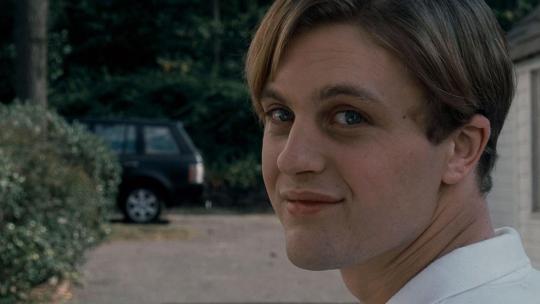
Later in the film, the fourth wall is further obliterated when Paul directly addresses the audience. This scene, in which Paul establishes a bet as to the fate of the family, is a mockery of audience expectation as Paul is clearly aware of his presence in a film and, as such, cannot lose. Despite this, much of the film manages to maintain suspense by foreshadowing false conclusions and utilizing minimally invasive cinematography. For example, silence coupled with slow and uneventful shots.
youtube
The principle example of the long immersive shot from this film lasts roughly ten minutes and follows the death of the son in the family. Rather than focus in on the reactions of each parent, the camera is placed across the living room and the audience is forced to watch what remains of the family attempt to free themselves from their bindings while weeping for the loss of their son. The impersonal nature of this extensive shot forces the audiences to analyze the situation and empathize with the survivors. This invest the audience back in to this unsustainable movie universe.

“Projection and reflection take place in a closed space, and those who remain there, whether they know it or not (but they do not), find themselves chained captured or captivated.” -Jean-Louis Baudry
In Summary
Cinematography is the presentation of a story in the form of film and choices in cinematography determine the audience’s relationship with the film. In The Third Man, the cinematography creates an ominous tone in which nothing is certain. In Funny Games, the cinematography is at times excessively realistic while at other times openly cinematic in order to criticize audience fascination with violent cinema. Both films are able to mislead there audience as to the truth through their cinematographic choices.
Discussion Questions
What are some other films you have seen that use dutch angles and how do these angles effect the tone?
What are some other films you have seen that mislead you and how did they achieve this effect?
What are some films that you can think of in which cinematography enhanced the story being told and in what way did it enhance the story?
0 notes
Text
Film Analysis Leader Presentation
Understanding Bazin’s Language, Mise-en-Scène, and the Immigration Influence in Film
For this presentation, I will be discussing how André Bazin’s “The evolution of the Language of Cinema” provides a basis for argument that relates to the immigration factor in Gurinder Chadha’s film Bend it Like Beckham, and Chris Buck and Kevin Lima’s film Tarzan (1999 Walt Disney).
André Bazin explains the concept of focus and how one must focus on the faith in reality, focus on the faith in image, or simply have a deep focus that allows for a true consideration of what is happening in the scene. He explains that the images and flow of a film tell a story that captures the audience and makes them part of the lifestyle in which the characters live in. The positioning of objects, the incorporation of different frames, and the reality of visuals in frame could add to this faith in reality. Both films I will be discussing use this focus on objects and the lifestyle situations in which our main characters find themselves to show the struggles of life and how overcoming adversity is something that immigrants face when entering a new world or having other enter their world.
Since the determining technical factors were practically eliminated, we must look elsewhere for the signs and principles of the evolution of film language, that is to say by challenging the subject matter and as a consequence the styles necessary for its expression. - André Bazin
Bend it Like Beckham
(2002) Director: Gurinder Chadha
“No one imagined that the movie was going to be so huge” - Gurinder Chadha
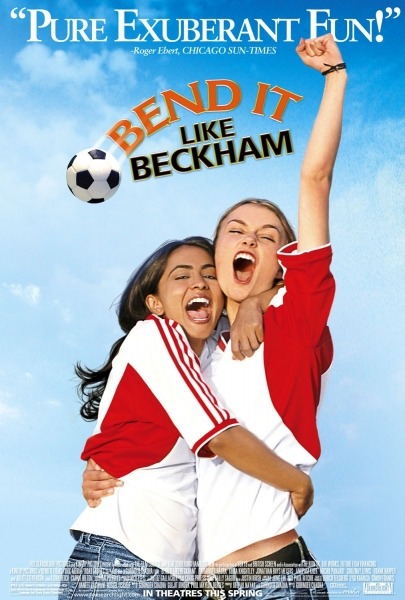
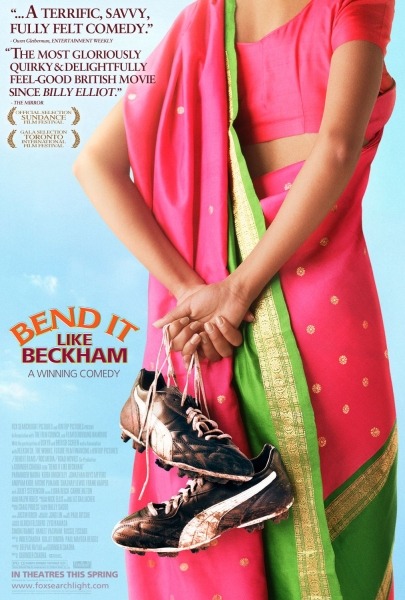

Bend it Like Beckham is a fusion of genres that introduces the cultural clash between a traditional Indian family and modernizing England. This film fits into the drama, romance, sports, and comedy genres. It is a perfect movie for a family night and portrays a deep meaning for people of all cultures.
The film follows Jessminder “Jess” Kaur Bhamra and her passion for the beautiful game (football, soccer, fútbol). Being a woman in a traditional Indian household, Jess is destined to be married to a proper suitor, learn how to be a household wife, and stay within the cultural boundaries. Her passion which is influenced by fellow Englishman and footy legend David Beckham, is her drive to pursue her dream of playing pro. When she was seen by semi-pro club player Jules, she feels that her love for the game is truly more than just pick-up games in the park.
Jess is forced to face her family, her friend, her culture, and herself. She escapes from her house multiple times to make it to practice and games. Her blind love for her coach puts her relationship with Jules in jeopardy and ruins her cultural boundaries. When faced with the decision of attending her sister’s wedding or the Championship game, Jess is faced with the ultimate struggle of deciding her future as a traditional Indian woman or a modernized, more lenient, and independent Indian/English woman.
This film tackles the immigration issue of acceptance of different cultures. It also opens the conversation of sexual orientation. In multiple instances we see characters struggle with the issue of sexual acceptance and this adds a different twist to the film. We also see an approach to gender equality and how woman can play professionally and how they can be more than just house wives.
Chadha is brilliant with this film and she herself is amazed with how much she accomplished with this simple film. The film really puts to use the background of the scenes. There are always objects in the scene that are not the main focus but provide support to the idea of cultural differences being a struggle for immigrants.
youtube
youtube
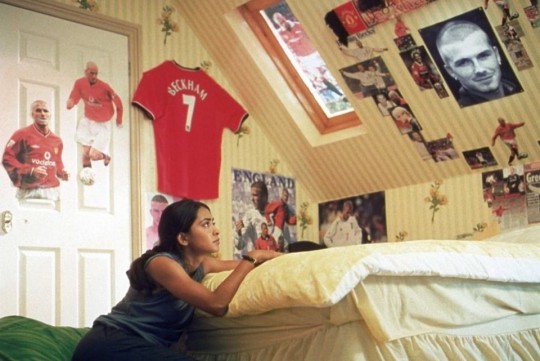

Tarzan
(1999) Directors: Chris Buck, Kevin Lima

Tarzan is a childhood classic. This is my favorite Disney movie and it happens to be the first movie I saw in theaters as well. As I have grown older, I have become more aware of a deeper meaning in this film. I may be overthinking it but following Bazin’s rules and understandings I have come up with certain arguments of my own. Some of my arguments support this idea of immigration. Contrary to Bend it Like Beckham, Tarzan is not a film about a family moving to a new country, instead it presents this idea of people coming to a new world. The “normality” is with the newcomers instead of being with those that reside already. It is the complete opposite to Chadha’s film but still reaches the same meaning about how immigration comes alongside with struggle. Immigration isn’t a wrong thing its just something that presents a difficulty to either the immigrants or to the inhabitants.
We all know the story line to this film because its a classic. However, have you taken a moment to fully analyze the small details that make Tarzan so unique? The moment he discovers the truth of his real family is probably the biggest part of the movie and the start to the climax of the film. A man raised by apes discovers he is not an ape but truly one of the new guys on the island, must decide whether to abandon his lifestyle to become part of this “correct” lifestyle for man. Disney adds in magic to make the film for children and to make it fantastical, but according to Bazin, its those special scenes that can make an audience have faith in a film with complete disregard to whether it is 100% CGI or 100% real.
Below are some of those important scenes in Tarzan that are of great importance. Pay close attention to the camera angles, and the insane amount o eye contact. The change in facial expressions also reveals the emotions the characters are going through.
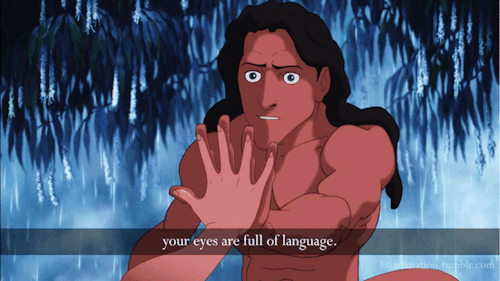
youtube
youtube
youtube
Discussion Questions
What are some other films that deal with immigration? What are some of the scenes in those films that create a faith in reality according to Bazin?
Besides traditional clothing and language differences, what are some other examples of cultural differences you have noticed in films? (Could be any film)
The topic of cultural difference and immigration is sensitive at times which makes it a difficult subject to make a movie about. In your opinion, which genre facilitates the task of presenting a difficult topic to film?
Deleted Scenes
https://youtu.be/xuK6m5-wW7A
http://mentalfloss.com/article/76972/18-winning-facts-about-bend-it-beckham
4. What is your favorite Disney movie? (If not Tarzan, please provide reasoning)
3 notes
·
View notes
Text
Bazin, Mise-en-Scène, and Animation - Discussion Leader Presentation
“The image...has at its disposal more means of manipulating reality and of modifying it from within.” --André Bazin
Using animation as a medium can add to the mise-en-scène of a film. Besides providing a looser means for implementing the fantastical, animation can exaggerate and place greater emphasis on how the “plastics” of a frame look through art style, color, and lines. This analysis will examine Persepolis and The Incredibles, two animated films that use animation to stress themes, settings, and characters.
Persepolis (2007), Dirs. Marjane Satrapi & Vincent Paronnaud
“Drawings, with their abstract quality, emphasize the universal. It doesn’t matter who, a dictatorship’s a dictatorship, whether in Chile, in China, in Iran or anywhere else, it’s the same.” --Marjane Satrapi, Persepolis co-director

Persepolis is primarily framed as a coming-of-age story: Marjane struggles to find and accept her identity as she grows up during and following the Iranian revolution in the 70s and 80s.
The film uses the framing device of Marjane in the airport, moving to France as she reflects on her life and events leading up to her permanent departure from Iran. Persepolis is primarily told in black-and-white flashbacks, while the present day is in color.
Besides reflecting the comic-book source material, the use of black and white adds to movie’s simplistic art style. This simplicity makes the film easily accessible (see above quote) in terms of understanding the characters, Iranian history, culture, and themes. This art style could also reflect Marjane’s nostalgia and views about her past in Iran, viewing it as strict, with clear-cut rules about what is considered right and wrong.
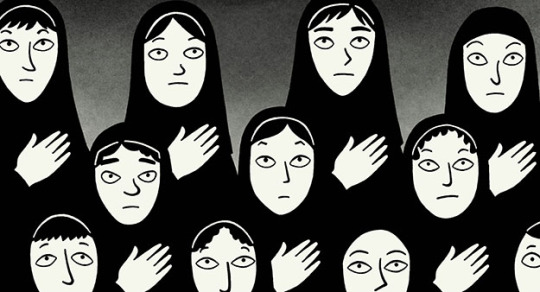
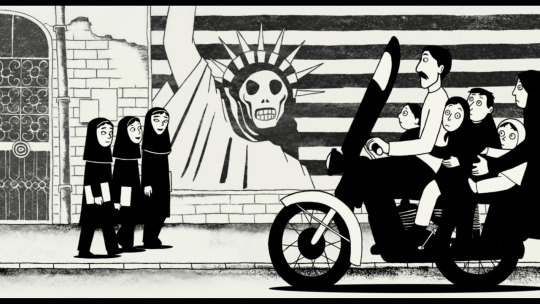
In the scene below, Marjane is confronted by two Muslim nuns for how she is dressed. The nuns' veils are used to silhouette them, looming over Marjane and creating the illusion of the two enveloping Marjane.
youtube
The Catholic nuns Marjane stays with in Vienna share a similar appearance to the Muslim nuns. From Marjane's perspective, both groups of women stifle her individuality, giving her the fuel to rebel. Parallels between each scene--it’s hard for Marjane to express her identity in both Iran and Vienna

Examples of exaggeration: Marjane embracing her nationality (top), Marjane experiencing puberty (bottom)
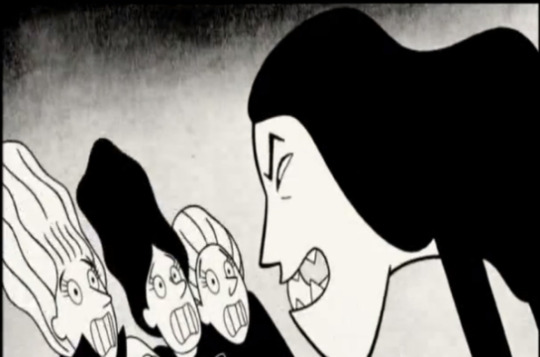
youtube
The Incredibles (2004), Dir. Brad Bird
“Animation is about creating the illusion of life. And you can't create it if you don't have one.” --Brad Bird, The Incredibles director

The Incredibles uses a retro, 50s/60s aesthetic throughout to emphasize the ideals of the suburban, nuclear family, as the Parr family are forced into traditional family roles they are not necessarily content with and prevent them from thriving.

This art direction helps depict the conflict and clashing of the mundane vs. the “incredible,” a theme that’s explored throughout the film as the family struggles to assimilate into a uniform society while trying to embrace their unique superpowers. By the end of the film, there is a literal explosion of the family’s house, symbolizing the ultimate destruction of the Parr’s traditional, nuclear family in favor of a “super” one.

Color and lighting are used to further convey the feelings of characters. In the opening scene, bright, golden colors are used to emphasize how Bob and Helen view their superhero days as nostalgic, romantic and as the “glory days”. A glow is added around everything to further stress this, and the shadows are bolder and more dynamic to create a comic-book-esque feel and tone, meant to contrast with the mundane life that the family is forced to adopt later on.
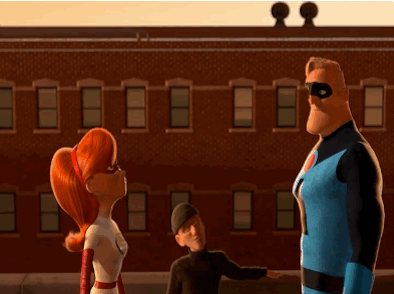
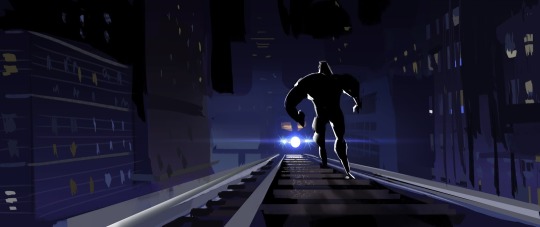
In contrast, all the color is desaturated and the depth of focus is flattened, showing Bob’s mid-life crisis and claustrophobic discontent with his forced retirement.

“Montage gave birth to film as an art, setting it apart from mere animated photography, in short, creating a language” --André Bazin
This scene is a great example of a “parallel montage”, described by Bazin as a montage that conveys simultaneity of two seemingly separate plot lines. In this context, the montage is used to show the major consequences of Bob’s actions on his family and the world, and it also acts as a middle-mark climax that leads into the next half of the film.
youtube
Discussion Questions
What are some other films (animated or live-action) that have a distinct art style or visual aesthetic, and how might that style contribute to mise-en-scène and the film’s overall story and characters?
How can color (or lack thereof) impact the way a film’s story is told and presented? Give some examples.
Both Persepolis and The Incredibles use stylized character silhouettes and designs to depict a character’s personality and feelings. What are some other animated films that use exaggerated character designs to convey actions and character traits in the frame?
1 note
·
View note